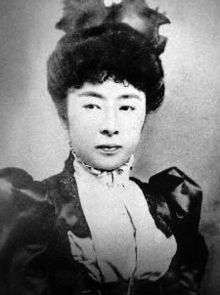Utako Shimoda
Utako Shimoda (下田 歌子, Shimoda Utako, September 30, 1854 - October 8, 1936) was a Japanese educator and poet of the Meiji and Taishō period. Born in present-day Ena, Gifu, she was the founder of what is today Jissen Women's University.

Biography
Utako Shimoda was born into a samurai family as Seki Hirao, in Gifu Prefecture. In the run up to the Meiji Restoration, the Hirao family were firmly on the side of the Emperor, and when the Shogunate fell, Utako's father was given a prominent position in Tokyo, where the family moved in 1870.
Seki was well-educated and recognised as an excellent poet, so much so that the empress changed her name to Utako (poem child).[1]
In 1879 she married the swordsman Takeo Shimoda, but when he fell ill Utako was forced to open her house as a private school, teaching poetry and Chinese classics to the wives of a number of ex-samurai officials. Takeo died in 1884 and Utako threw herself into her work as a full-time educator, becoming a teacher and principal at the Girls' Peer School. Her interest in women's education took her to Europe (where she enjoyed an audience with Queen Victoria) and America for two years, returning to Japan in 1895 with a raft of new ideas to overhaul Japanese education for women, with equality of education for men and women being the main tenet. In 1899 she established Jissen Women's University for Japanese women and female Chinese exchange students.
Utako Shimoda's vision and work did much to modernise and improve women's education in Japan (she is even responsible for the navy-style girls' school uniform), not just in the realm of improving the mind, but in physical education as well. She was an early student of Jigoro Kano, the founder of modern Judo. She founded three women's schools and wrote over 80 books. She died from pneumonia in 1936, aged 82.
References
- Suzuki, Mamiko (1 June 2013). "Shimoda's Program for Japanese and Chinese Women's Education". CLCWeb: Comparative Literature and Culture. 15 (2). doi:10.7771/1481-4374.2212.
- The Way of Judo: A Portrait of Jigoro Kano & His Students by John Stevens (Shambhala, 2013)